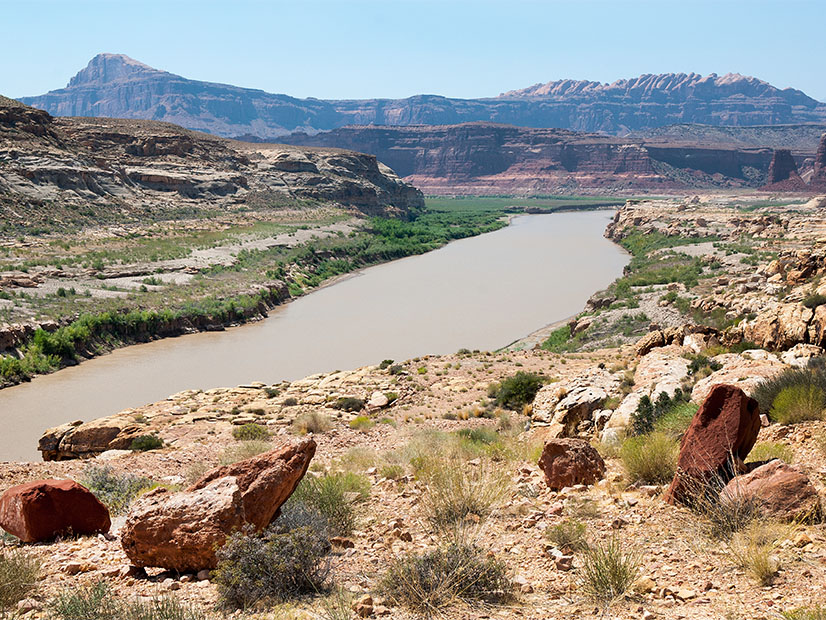FERC on April 25 denied an application for a 3.6-MW pumped storage hydropower facility on the Little Colorado River in Arizona — near the Grand Canyon and entirely on Navajo Nation land — after the tribe protested that it had not been consulted by the developer (P-15024).
The order, approved unanimously at FERC’s monthly open meeting, follows a commission policy issued in February saying it will not issue preliminary permits for projects proposing to use tribal lands if the affected tribe opposes the permit. Tribal lands are administered directly by the U.S. government, not by the states in which their territory lies. FERC said this makes the policy consistent with how it has treated permit applications opposed by federal land managers or similarly affected federal agencies.
“Because the proposed project would be located entirely on Navajo Nation land and the nation has stated that it opposes issuance of the permit, we deny the application,” FERC said. “To avoid permit denials, potential applicants should work closely with tribal stakeholders prior to filing applications to ensure that tribes are fully informed about proposed projects on their lands and to determine whether they are willing to consider the project development.”
The developer, Pumped Hydro Storage, argued that because it had filed its application in 2020, the new policy should not apply to it. It also claimed that gaining tribal approval is difficult before being granted a permit, but that gaining one would give it more “resources” to consult with the Navajo.
“We are not persuaded by Pumped Hydro’s arguments,” FERC said. “Pumped Hydro provides no support for its assertions that gaining tribal approval at the permit stage is particularly difficult and that issuance of a permit, which is simply a placeholding action, would provide any additional resources to a developer.”
The developer had named the proposed project the “Navajo Nation Big Canyon Pumped Storage Project,” but the text of the order omitted “Navajo Nation” from the name and refers to it simply as “Big Canyon” throughout. In an unusual footnote, FERC said the project was “not in any way affiliated with” the tribe, so it removed it from the name “to avoid the impression that the Navajo Nation is involved in developing the project.”
The project would have consisted of three new dams with walls spanning a collective 11,450 feet, a building to house nine 400-kW turbines and two double-circuit 500-kV transmission lines, among several other facilities. The Navajo Nation said it would adversely impact its water use and historic and cultural resources. Other commenters raised concerns about the fitness of the developer for such a project and the application’s completeness. The commission did not address these concerns.
“This disastrous project could have devastated the Little Colorado River and pushed the world’s last large source population of humpback chub toward extinction,” Taylor McKinnon, Southwest director at the Center for Biological Diversity, said in a statement. “It’s good news for these embattled fish that federal officials heeded the Navajo Nation’s staunch opposition and rejected this project.”
Cabin Run Permit Approved
FERC did approve a preliminary permit for Cabin Run Pumped Storage to study the feasibility of a 57.5-MW, closed-loop pumped storage hydropower facility near the Stony River in Tucker and Grant counties, W.Va. (P-15318).
The West Virginia Division of Natural Resources, Potomac Riverkeeper Network and Friends of Blackwater opposed the permit, arguing the project would adversely impact the river’s habitats, especially those of the native brook trout.
The commission did not address these arguments, noting that “a preliminary permit does not authorize access to project lands or project construction. Therefore, addressing the commenters’ concerns at the permit stage is premature.”
“The purpose of a preliminary permit is to secure the permit holder’s priority for filing a development application while it studies the feasibility of a project, including studying potential impacts, such as those identified by the commenters here,” FERC said. “The commission will consider in any future licensing proceedings potential project effects on water quality, water quantity and nearby infrastructure. Accordingly, it would be prudent for the permittee to consider and study these issues during the term of the permit.”
That term ends April 1, 2026.



